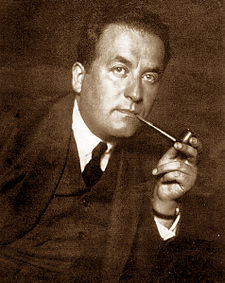1. Shmuel Yosef “Shai” Agnon was born Shmuel Yosef Halevi Czaczkes in a shtetl in Galicia, Austia-Hungary (now Ukraine) in 1888. His father, who worked in the fur trade, was a rabbi who aligned himself with the Chasidim; his mother came from a family of Mitnagdim, who opposed the Chasidic movement.
2. After early education in a cheder, he was schooled at home by his parents. From a young age, he wrote poems and stories in Hebrew and Yiddish. He learned German from his mother and read widely. For much of the rest of his life, he was an observant Jew.
3. In 1908 he left Europe and settled in Jaffa. That same year, he published the story “Agunot” (“Forsaken Wives”) using the surname Agnon, which he was ultimately to adopt officially (1924) – wouldn’t you, if you had his last name?
4. He moved to Germany in 1913, where he met Zalman Schocken, who took him under his wing, becoming his patron and supporting him so that he could write. He married there in 1920.
5. He collaborated with Martin Buber on a collection of Chasidic stories. His prose works were published regularly in Haaretz, in the weekly journal of Hapoel Hatsair and abroad. In 1924, his personal library in Germany burned down. Later that same year, he returned to Palestine, settling in Jerusalem. In 1929, his library was again destroyed by fire, this time in an anti-Jewish riot.
6. His place in Hebrew literature was assured when, in 1931, the Schocken publishing house published his novel The Bridal Canopy (Ha chnasat Kalla) to great critical acclaim.
chnasat Kalla) to great critical acclaim.
7. His work reflects the conflict between traditional Jewish life and language, and the modern world – on being of both worlds, but belonging fully to neither. The shtetl landscape is the background for many of his stories (notably A Simple Story); others focus on the Zionist movement and contain historical figures (notably Only Yesterday). He said his inspiration came “first and foremost [from] the sacred scriptures, and after that, the teachings of the medieval sages, and the spectacles of nature and animals of the earth.” At another time, he claimed that his primary influences were the Bible, German literature and European literature in general.
8. He employs a unique idiom, rife with terms from the traditional literature in favor of terms from modern Hebrew; critics have found in his language references to the Torah, Prophets, Mishnah, midrashic and rabbinic literature. The work is a challenge to translate, because it is full of allusions, wordplay, acrostic and anagrams. Nonetheless, he has been translated into no less than eighteen languages. He brought to literature a broadened conception of the narrator’s role.
9. These are his major works: The Bridal Canopy (1931), In the Heart of the Seas (1933), A Simple Story (1935), A Guest for the Night (1938), Betrothed (1943), Only Yesterday (1945), Edo and Enam (1950), To This Day (1952). After his death, his daughter continued to publish his work posthumously: Shira (1971), A City and the Fullness Thereof (1973), In Mr. Lublin’s Store (1974). In addition there are several collections of short stories and an edition of folk tales and rabbinic texts that he edited.
 10. Agnon has had enormous influence on later writers, both in Israel and beyond. I, myself, used his work as source material for my novel Rivka’s War, to gather a sense of the daily life of pioneers in Eretz Yisrael. He won the Bialik Prize twice, and the Israel Prize twice, and in 1966 was awarded a Nobel Prize “for his profoundly characteristic narrative art with motifs from the life of the Jewish people.” His likeness, his works, and an excerpt from his Nobel acceptance speech are printed on the Israeli fifty-shekel bill. So great was his fame that in his later years the city police closed off his street to cars so that the noise would not disturb his writing!
10. Agnon has had enormous influence on later writers, both in Israel and beyond. I, myself, used his work as source material for my novel Rivka’s War, to gather a sense of the daily life of pioneers in Eretz Yisrael. He won the Bialik Prize twice, and the Israel Prize twice, and in 1966 was awarded a Nobel Prize “for his profoundly characteristic narrative art with motifs from the life of the Jewish people.” His likeness, his works, and an excerpt from his Nobel acceptance speech are printed on the Israeli fifty-shekel bill. So great was his fame that in his later years the city police closed off his street to cars so that the noise would not disturb his writing!
11. His home, built 1931 in the Bauhaus style in the Talpiot section of Jerusalem, is now a museum, Beit Agnon. The synagogue in that area is named for him, as is a Jewish school in Ohio.
12. When he died in Israel in February 1970, a state funeral was held on the Mount of Olives.
In Jerusalem, Shay Agnon Street is the main drag in Givat HaPorezim. In Haifa, you’ll find Shay Agnon Street running parallel to Derech Stella Maris and Derech Allenby, between the two.


